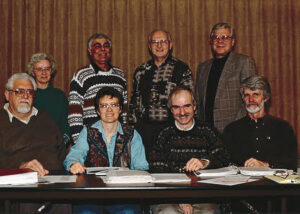Two readers recently wrote to me with concerns. “Over the years that we have received [CM],” wrote a Manitoba couple, “we have detected a constant shift toward liberal theology. . . . de-emphasizing evangelism, Christ’s life and ministry, and his death for our salvation.”
The other person, from B.C., said CM articles cover “many salient topics and issues” but “never refer to 1 Cor 3:11 [which reads:] For no other foundation has any one laid than that which is laid, which is Jesus Christ. Surely you don’t need reminders of it?” he asked.
The letter writers raise a fair point. Canadian Mennonites are often uncomfortable with evangelistic practices if the emphasis is on converting people. It’s also true that Mennonites do not spend much time preaching about salvation from sin.
I disagree, however, that articles in this magazine de-emphasize Christ’s life and ministry. On the contrary, articles in these pages show Mennonites deeply committed to Jesus’ way of peace and love, working as communities to bring healing and hope to a hurting world.
Still, given that church attendance is in decline across Canada, it’s reasonable to suggest that we might be missing something.
This issue presents “Witness” by Doug Klassen, executive minister of Mennonite Church Canada. Klassen gives snapshots of Mennonites in five countries. We see that in Ethiopia, thousands of people are joining the church each year through an approach of prayer, baptism and “strategic evangelism.” In the Philippines, Congo and elsewhere, Mennonites have been powerful witnesses for peace. Their work attracts new believers.
The global Mennonite church can’t have grown to 2 million believers in 86 countries without some kind of evangelism. Perhaps some of this spread has come about through the sort of embodied evangelism that Menno Simons spoke of: “True evangelical faith cannot lie dormant; it clothes the naked, it feeds the hungry, it comforts the sorrowful and shelters the destitute.” Mennonites still hold strongly to that vision of evangelism and discipleship.
Elsewhere in this issue, columnist Joon Park writes how Christian identity has been formed over the centuries from Biblical times until today, always adapting to cultural, social and geographical influences. Park challenges Mennonite churches in Canada to continue adapting to new influences brought to the church by non-European Mennonites.
We are often uncomfortable when challenged to change the way we think or do things. We are bound to disagree with at least some ideas. In some cases, members of the church are deeply divided—not usually about whether baptism should be by immersion or about what kind of hymns we sing. Instead, the deep divide is over fundamental theological ideas such as how our communities welcome LGBTQ+ people or how to express evangelism.
Troy Watson addresses this challenge in his column, reminding us to stay in communion with other Christians even when they “embody attitudes, values, behaviours and beliefs that, in my opinion, are diametrically opposed to the teachings, character and heart of Jesus.”
This issue contains numerous other articles that show Mennonite faith and practice at work. Senior writer Aaron Epp talks to five Mennonites about Lenten spiritual practices. In our semi-annual Focus on Education, Mennonites schools tell their stories.
In a story by Angelika Dawson, supportive care worker Ashleigh Singleton shares how God transformed her life. “Now I know that my identity is in Jesus,” Singleton proclaims.
In the feature, Klassen challenges us to consider what we are doing in our neighbourhoods to extend the peace of Jesus Christ. Mennonites in other countries are doing so courageously.
As 21st-century Mennonites in Canada, we may need reminders like those of the two letter writers, to be more explicit in acknowledging the motivation behind our faith and practice. If we fail to mention that “Jesus is the center of our faith” to quote Palmer Becker’s Anabaptist Essentials, do our actions on Indigenous-settler reconciliation, or the environment, or refugee sponsorship, etc. look any different from those of a secular group?
The Manitoba letter writers said that CM “articles are often not distinguishable from other cultural magazines.” They cancelled their subscription.
I acknowledge those of you who are still reading and thank you for staying engaged.
Read more editorials:
Peace and popularity
The holy paradox of modern Mennonite identity
Tuning out of Advent
2,000 years later in Bethlehem . . .
My prayer









Leave a Reply
You must be logged in to post a comment.